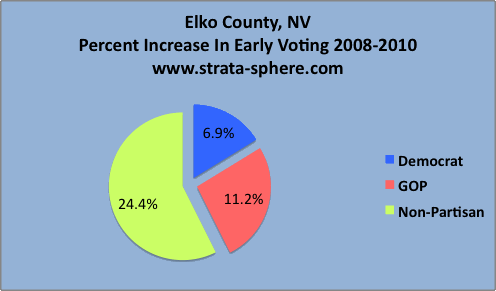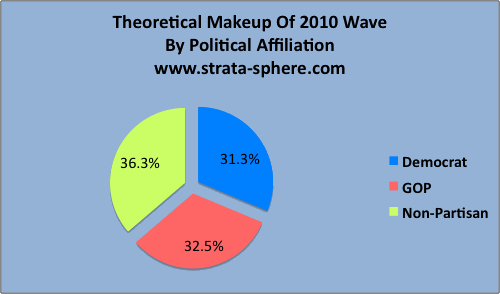Oct 17 2010
What A Centrist Tsunami Would Mean To Democrats
In my previous post on the ‘most likely of voters‘ (those who requested absentee ballots and only have to submit them to transition to a ‘true voter‘ status) should not be underestimated or dismissed out of hand. The data from Nevada indicates a high probability that most pollsters are way off in their predictions for this election cycle. This is due to the turnout models being stuck on past election patterns, as opposed to what may be actually happening this year. In that post we saw a great set of data from Elko County, NV where they compared 2008 absentee ballot data to the 2010 data. The key aspect of this early voter data is the party affiliation details provided. If Elko is a microcosm of national trends (and there is no reason to suspect it is not), then it indicates an election like nothing we have seen before.
Here is the summary chart showing the increase in voter interest in 2010 over the massive presidential election year of 2008 (click to enlarge).
What is interesting about the data is how ALL party affiliations show a significant increase in absentee ballots in 2010. Overall there has been a 13% increase in absentee voting this cycle, which would indicate a high turn out cycle. But this is NOT just a typical increase in absentee ballot usage. As the chart shows the increase is not uniform across party affiliation. (note: the three groups shown represent 95% of the absentee ballots, the remaining 5% being scattered across smaller parties ranging from left to right)
The well advertised enthusiasm gap between Democrats and the GOP is clear in the data – Dems are up 7% in 2010, but the GOP is up 11%. However, the real surprise (to me) was the 24% increase in the enthusiasm of independents, and that is why the polls are probably not accurately measuring the wave of anger out in the nation.
In Elko County, NV – where the GOP represents ~56% of the voters, the Dems are ~24% and independents ~15% – this will not impact how the voters will vote in 2010. This surge of independent voters is only going to give the GOP a bigger edge, since independents run +20% towards the GOP in all the major polls put out across the country (as seen in this chart by Jay Cost at the Weekly Standard).
So in Elko County, the voters will be just a lot redder as the GOP and Independents combine to swamp the already outnumbered Democrats. Where this is important is in state-wide races and swing districts were the independents are more on par with the Democrats and the GOP. In a theoretical race where each of the three groups are at parity (all at 33.3%) in 2008, I have computed the impact of a wave that follows the parameters of Elko County – i.e., Dems up 7%, GOP up 11% and Indies up 24%. The resultant turnout model is shown in the following chart:
What can happen in a swing race if the wave is really strong with independents is crystal clear. While increasing their turnout by 7% over 2008, the Dems still lose 2% overall. The GOP increases their turnout by 11% over 2008, but also lose ground in the overall numbers by 1%. This is all due to the fact the surge by independents dwarfs both the GOP and Democrat increases. This wave is so large the Independents grow their numbers by 24% and take the lion’s share of the overall vote, coming in at 36.3% – an increase of 3%!
Since the GOP and Democrats can pretty much guarantee their base by 95-5%, it is that +20% advantage for the GOP with independents that makes all the difference in actual outcome. Bottom line: even if the Dems can motivate their base to 2008 levels, it won’t help them.
The real question is how big an edge do the Dems require from 2008 to win with this kind of surge in GOP and independent voters in 2010? Where is their safe ground under these conditions?
To do this we compute what lead in Dem support in 2008 would offset the combined surge in the other two categories in 2010 using the above turnout model. There are numerous scenarios that can end with the Dems just barely beating the GOP in this theoretical model, one of them being a 2008 mix of 40D-30R-30I. That means if Dems +10 are over the GOP in 2008, they would then be safe in 2010 for this model, assuming the kind of independent/GOP tsunami we see in Elko County absentee ballots. These D+10 2008 races would barely win in 2010. A D+9 2008 race would barely lose in 2010. This indicates that a D+9 2008 ranking seems to be where the 2010 tsunami can reach.
That makes sense, given the nearly 100 house seats the professional prognosticators have in play, and why the GOP is still on the verge of taking the senate. This centrist wave is very critical in state wide races, where there is near parity across the three main political affiliations. Few states are D+9, which explains why WV, WI, CA, WA, CT and DE are in play. That also explains why 2010 is very different than previous cycles.
It is extremely rare for the force of an election to come out of the non-partisan center. This is what happened in NJ and VA in 2009, and in MA in 2010 when Scott Brown won Kennedy’s seat. It is why most pollsters are struggling to get a handle on what is happening. Who in their right mind would boost the independents over the party stalwarts?? But that is clearly what is happening in Elko County, NV. And I would argue it is happening across the nation.
Update: Some additional must reads to compliment this data. First, a new poll showing how Obama’s left of center coalition is crumbling:
Nearly two years after putting Obama in the White House, one-quarter of those who voted for the Democrat are defecting to the GOP or considering voting against the party in power this fall. Just half of them say they definitely will show up Nov. 2, according to an Associated Press-Knowledge Networks poll released two weeks before Obama’s first midterm elections.
This is really bad news for the dems, because it seems Obama and the liberals in Congress did motivate the voters – to come out and reject their liberal agenda. Second, a post by Sean Trende at RCP highlighting one of the main reasons I keep saying 2010 is not like 1994 – it is much worse:
But this is a different kind of election than 1994, entirely. When my lay friends ask about this election, I explain that it is like seeing Haley’s Comet; you’ll usually only get to see it once in your lifetime. The economy is sluggish, the President has pursued an ambitious, controversial agenda, and the party is badly overexposed, with numerous first- and second- term Democrats occupying districts that had been sending Republicans to Congress for decades.
Trende notes all that vaunted preparation by the Dems to avoid another 1994 were misplaced and did not address the forces at work this cycle. Like a centrist wave rising up instead of a partisan one.









Nothing hurts like voters who figure out you lied to them … Build it high, was all the crude out of Washington.
I was stunned at how viscous my former Obama supporting neighbors were to Democrats !!! It had completely flipped.
I guess they figured out it’s their economy too.
[…] AJ Strata examines what a centrist tsunami would mean to Democrats. […]
I see that early voting in Nevada had already started. Any mention on voter turnout?
Less than one day for Texas for early voting as it starts tomorrow. All [non-election] judges and candidate judges are going to work all polling booths and are asking for volunteers to hand out [paper] ballots. I don’t remember ever in the past that the [non-election] judges were involved in handing out paper ballots. Anyone? It’s to minimize voter fraud.
[…] we’ll keep control of the House and Senate – hotair.com 10/17/2010 Hope. more… What A Centrist Tsunami Would Mean To Democrats – strata-sphere.com 10/17/2010 In my previous post on the ‘most likely of voters‘ […]
Let the wave begin!!
By the way, look for Dems to start their own tsunami of (extremely) negative ads nationwide as they desperately attempt to salvage what they can from this election…
The dems have retreated from the moat, from the castle walls, from the castle halls, and hallways and are desperately defending their inner staterooms.
Look where they go, they are defending their inner city cesspools and college campuses because they have lost the 60% who would repeal obamacare, hate the stimulus and fear cap and trade and the 17 percent unemployment rate. they may salvage thier violent and insane base but have lost the reagan democrats and vast majority of indies!
For once in his life Dingy Harry uttered a trueism, the war is lost, to the demrats!
The local TV ads are starting to get nastier.
Today opens Early Voting for Texas! Yay!
lurker9876on 17 Oct 2010 at 11:01 pm
“The local TV ads are starting to get nastier.”
I have an easy solution – turn off the TV until November 2.
AJ:
I see a flaw in your analysis. You equate non-partisan or independant with “centrist.” Many may be centrist… the kind of jellyfish rolly polly voters who came over to Obama because he was cute, or nice, or charismatic, or “wouldn’t it be nice to finally have a black president?” type of voters. Many may be those who were fed up with George Bush and just wanted change.
But you ignore all the polls that indicate those now identifying themselves as conservative has skyrocketed. If many “independant” voters have seen hope and change and it has scared the heck out of them and they now are “conservative” (not necessarily Republican) then support for consevative republicans and tea party candidates may be much higher than thought.
Same result… but not due to “centrists”.
[…] As I noted yesterday, the real question is who is fired up to vote? And I have a sense that it is the independents that will be making the big wave this cycle. Typically one side is fired up and the independents tilt one way. But this year the grass roots Tea Party (which has been a co opted to some degree by conservatives) sprung out of the center-right region of the electorate. Fiscally conservative (low spending, low taxes) with a libertarian streak (limited government) that has a heavy dose of pro-military sense (strong defense, win the wars), these people were the ones who came out to the 2009 Tea Party rallies (I attended one in person in DC). […]